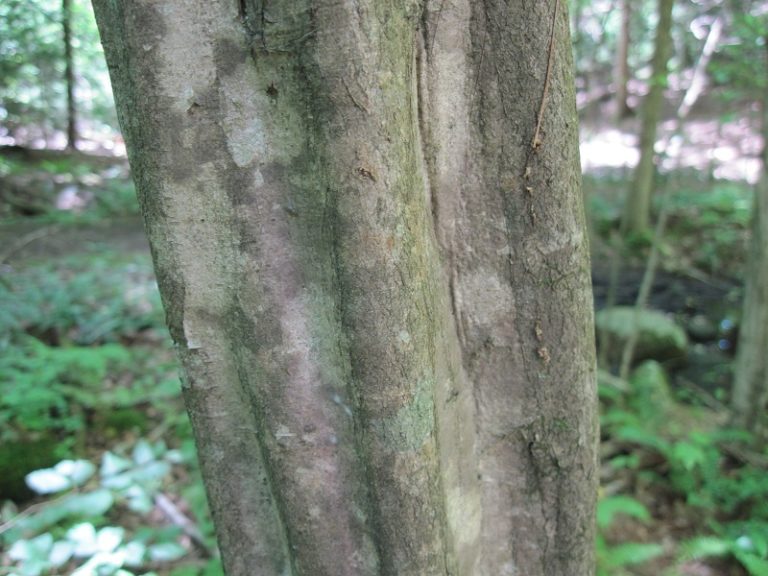Ironwood is a small to medium-sized (twenty to thirty-five feet) deciduous, understory tree that grows in woods throughout Eastern North America. It has handsome, smooth-textured, rippling bark (“Musclewood”) and alternate, doubly-serrated, oval leaves with a corrugated texture. The timber of Ironwood is of greater-than-average hardness and durability as suggested by its common name. It bears separate male and female catkins on the same individual tree (monoecious), the female catkins developing into the characteristic chain-like clusters of winged nutlets. Being an understory tree, it prefers part shade to full shade conditions and medium moisture. Ironwood can display bright color in autumn and has the great advantage of being low maintenance, and very low on the deer list of edible trees. The ssp. virginiana (“northern” is found more in our mountains, grading into the ssp. caroliniana on the coastal plain. Differences in leaf shape and bracts subtending the seeds are subtle.
NURSERY HOURS
Wednesday: 10-4 Thursday: 10-6 Friday-Saturday: 10-4 Sunday: 12-4
Carpinus caroliniana

Key Info
Scientific Name: Carpinus caroliniana Walter
Common Names: American Hornbeam, Blue Beech, Musclewood, Ironwood, Water Beech
Family Names: Betulaceae (Birch Family)
Plant Type: Tree / Shrub
Leaf Retention: Deciduous
Flower Color: Inconspicuous
Special Characteristics: Tolerates shade, Tolerates some wet conditions, Excellent timber, Interesting bark, Good fall color, Reported to be deer resistant.
Additional Info
Habit: Multi- or single-stemmed understory tree with oval or irregular crown, spreading branches; smooth, sinewy bark furrowing at the base over time; a shallow, wide-spreading root system.
Height: 25'-40'
Spread: 20'-35'
Soil Conditions: moist, well drained, pH acid to slightly alkaline, tolerant of clay
Leaves: alternate, simple, bright green, oval with pointed tip, doubly serrated margins and strong, parallel venation, 2-5 inches long; turn bright yellow to orange to red in fall
Flowers (or reproductive structures: Separate male and female catkins, the male catkins green, pendulous, several inches long; the female flowers consisting of an ovary with two delicate, red stigmata peeking out from under green bractlets at the ends of the stems.
Fruit: Female flowers at the tips of twigs develop in mid-spring into characteristic chains of nutlets, subtended by 3-lobed leafy bracts which turn tan when mature, in late summer/early fall.
Natural Distribution: Shady woods, stream banks, flood plains
USDA Hardiness Zone: 3 to 9
USDA Wetland Indicator Status in NC: FAC
Pollination: Wind
Wildlife Connections: Ironwood provides nesting habitat for various birds such as Wood Thrush, Black-capped Chickadee; various caterpillars, beetles and leaf hoppers feed on the foliage, wood and sap; nutlets are eaten by Wood Ducks, Ruffed Grouse, Bobwhite, pheasants and quail; Ironwood is larval host for the Eastern Tiger Swallowtail, Striped Hairstreak, Red-spotted Purple (Illinoiswildflower.info)
Propagation: Sow fresh seed in fall or stratify and sow in spring; Wikipedia says to cycles of cold/warm treatments are sometimes necessary.
